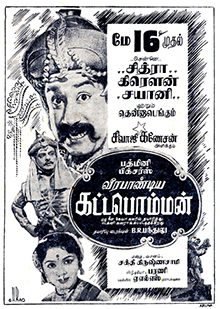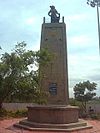
Ettayapuram is a panchayat town in Thoothukudi district of Tamil Nadu, India. It is the birthplace of Tamil poets Mahakavi Bharathiar and Umaru Pulavar. Muthuswami Dikshitar, one of the triads of Carnatic music, was patronized in his final years by the ruler of Ettayapuram.

Tirunelveli, also known as Nellai and historically as Tinnevelly, is a major city in the Indian state of Tamil Nadu. It is the administrative headquarters of the Tirunelveli District. It is the sixth-largest municipal corporation in the state after Chennai, Coimbatore, Madurai, Tiruchirappalli and Salem. Tirunelveli is located 624 km (388 mi) southwest of the state capital Chennai, 58 km (36 mi) away from Thoothukudi, and 73 km (45 mi) from Kanyakumari. The downtown is located on the west bank of the Thamirabarani River; its twin Palayamkottai is on the east bank. Palayamkottai is called the Oxford of South India as it has many schools and colleges. It has several important government offices.

The Polygar Wars or Palaiyakkarar Wars were wars fought between the Polygars (Palaiyakkarars) of the former Tirunelveli Kingdom in Tamil Nadu, India and the British East India Company forces between March 1799 to May 1802 or July 1805. The British finally won after carrying out gruelling protracted jungle campaigns against the Polygar armies. Many people died on both sides and the victory over the Polygars brought large parts of the territories of Tamil Nadu under British control, enabling them to get a strong hold in Southern India.

Dheeran Chinnamalai was a Palayakkarar and chieftain who ruled the Kongu Nadu region of the present day western Tamil Nadu. He fought against the British East India Company, was later captured and hanged by the British.

Thirumayam is a place of historical importance located about 22 km from the town of Pudukkottai & 22 km from the town of Karaikudi. The noted Indian independence activist Sathyamurthy was born in Thirumayam in 1887.

The region of Tamil Nadu in the southeast of modern India, shows evidence of having had continuous human habitation from 15,000 BCE to 10,000 BCE. Throughout its history, spanning the early Upper Paleolithic age to modern times, this region has coexisted with various external cultures.
Kayathar / Kayatharu is a panchayat town in Thoothukudi district in the Indian state of Tamil Nadu.
Ottapidaram is a small town in Thoothukudi district and headquarters of Ottapidaram taluk. Ottapidaram is a tourism centre with accessibility to many places in Tamil Nadu. Thoothukudi or Tirunelveli can be easily accessed from anywhere and Ottapidaram is very close to these two places. The great freedom fighter V. O. Chidambaram Pillai called VOC hails from Ottapidaram. VOC is also called as "Kappalottiya Tamizhan" because he launched one of the first shipping companies, Swadeshi Steam Navigation Company which operated ship between Tuticorin and Colombo against the British during the rule in India.
Sivagiri is a panchayat town and a tourist place in Tenkasi district in the Indian state of Tamil Nadu. Sivagiri is located at a distance of 50 km north to Tenkasi, 20 km south to Rajapalayam, 95 km north-west to Tirunelveli, 95 km south to Madurai, 540 km south to Bangalore, 150 km north to Thiruvananthapuram and 580 km south to the state capital Chennai.

Veerapandiya Kattabomman is a 1959 Indian Tamil-language historical war film produced and directed by B. R. Panthulu. The film stars Sivaji Ganesan, Gemini Ganesan, Padmini, S. Varalakshmi, and Ragini, with V. K. Ramasamy and Javar Seetharaman in supporting roles. Its soundtrack and score were composed by G. Ramanathan.
Panchalankurichi is a village, 3 km from Ottapidaram and 21 km from Thoothukudi in Thoothukudi district, Tamil Nadu, India. Panchalankurichi was once a Palayam and is best known as the birthplace of Veerapandiya Kattabomman, an 18th-century Palayakarrar ('Polygar'), who opposed the British East India Company governance in the area and its revenue-raising methods.

Palaiyakkarars, or Poligar, in Andhra and Tamil Nadu refers to the holder of a small kingdom as a feudatory to a greater sovereign. Under this system, palayam was given for valuable military services rendered by any individual. The word pālayam means domain, a military camp, or a small kingdom. This type of Palayakkarars system was in practice during the rule of Pratapa Rudhra of Warangal in the Kakatiya kingdom. The system was put in place in Tamilnadu by Viswanatha Nayaka, when he became the Nayak ruler of Madurai in 1529, with the support of his minister Ariyanathar. Traditionally there were supposed to be 72 Palayakkarars. The majority of those Palaiyakkarar, who during the late 17th- and 18th-centuries controlled much of the Telugu region as well as the Tamil area, had themselves come from the Kallar, Maravar and Vatuka communities.
Raja Sri Vijaya Raghunatha Tondaiman Bahadur was the ruler of the pudukottai kingdom from 30 December 1789 to 1 February 1807.
Sundaralinga Kudumbanar, also known as "Veeran" Sundaralingam Kudumbanar, was an 18th-century CE general from Tamil Nadu, India.
Oomathurai, was an Indian Poligar (Palaiyakkarar) from Tamil Nadu, who fought against the British East India Company in the Polygar Wars. He was the younger brother of Veerapandiya Kattabomman.

The Madras Presidency was a province of British India comprising most of the present day Tamil Nadu and Andhra Pradesh along with a few districts and taluks of Karnataka, Kerala and Odisha. A few princely states, notably Ramnad and Pudukkottai also merged into the Presidency at some or the other time. The Presidency lasted till 1950, when it became the Madras State after India became a republic. In 1953, Telugu-speaking regions of the state split to form Andhra State. Subsequently, in 1956, Kannada- and Malayalam-speaking areas were merged with Mysore and Travancore-Cochin respectively.
The Indian independence movement had a long history in the Tamil-speaking districts of the then Madras Presidency going back to the 18th century.

The Thirumayam Fort is a 40-acre wide fortress in the town of Thirumayam in Pudukkottai-Karaikudi Highway in Pudukkottai District, Tamil Nadu, India. It was constructed by Vijaya Raghunatha Sethupathi, the Raja of Ramnad in 1687. Later the fort was handed over to his brother in law Raghunatha Raya Tondaiman. The fort has been extensively renovated by Archaeological Survey of India in 2012.

INS Kattabomman is the designation of the VLF-transmission facility of the Indian Navy situated at Vijayanarayanam near Tirunelveli in Tamil Nadu. The facility spread over 3,000 acres has 13 masts, which are arranged in two rings around the central mast. The centre mast has a height of 301 metres, the masts on the inner ring measure 276.4 metres, that on the outer ring measure 227.4 metres.
Panchalankurichi Fort was a fort once ruled by the polygar Veerapandiya Kattabomman.












